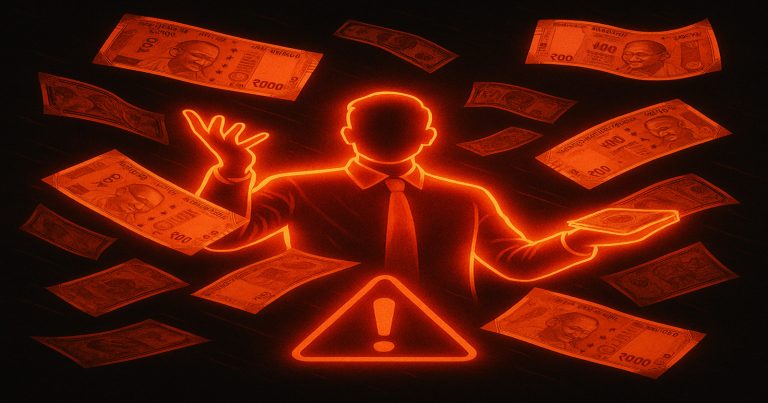The Bhushan Bhatt scam, a somewhat frequently ignored but critical part of Indian financial history, was the smaller, but equally fierce-looking, black sheep in the stock market industry at the time of the exposure of the Harshad Mehta scam in the media. Its constituents, stringent manipulation, insider trading, and collusion with banks for immoral material gain, destroyed moneylenders and burdened the institutional credibility of that stock market with an unforgettable bitter memory. Just when the spirit of economic liberalisation was taking root in India, formidable market forces such as Bhushan Bhatt were having a magnificent day because even the values in the stock market were determined not by scientific wisdom but by the values of bruised integrity, inside information, connivance, and changeable priorities. The Bhushan Bhatt scandal was an essentially replicated version of a male music band, minus Bhushan Bhatt; the others were just mugging up, pushing the notes out from their throats, and then forward.
What Was the Bhushan Bhatt Scam of 1992?
The Bhushan Bhatt scam, which derived sheer excitement during the early ’90s, is a very complicated financial deception that works within the circumference of the loopholes present in the stock market. Bhushan Bhatt, the then-reputed broker, successfully manipulated prices of various scrips by employing the most unethical practices, such as insider trading or market rigging. Inflated prices were then in league to offload many shares carefully nursed to assume hyper-growth to gullible investors. At its embryonic stage, the whole thing was based upon deceit and a chaos of the regulatory mantras meant so precipitously. Mehta, of his own accord or through his dealers, used insider information of heretofore unheard-of magnitude to make sizeable profits by playing the fluctuations in share prices, doing so well before anyone in the public noticed them.
How Did the Bhushan Bhatt Scam Unfold?
The Indian securities scam of 1992, mainly attributed to Harshad Mehta, was a turning point in India’s financial history. Besides, like Bhushan Bhatt, less-known players were the almighty players in the fraud scheme that nearly brought the stock market to its knees. Bhatt, a broker and accomplice of Mehta, virtually took part in setting up a parallel rigging of the financial system and undermining loopholes with the aid of forged documents and cognisance of a few banks. The methods used to achieve and execute the scam were far less formal but much simpler and differed in some contexts; the only razor-sharp way to achieve the goals was within the same prank. So, below are ten vital strategies and mechanisms upon which the Bhushan Bhat scam operated during 1992.
1. Fake Bank Receipts (BRs)
Fake Bank Receipts (BRs) were used rampantly by Bhushan Bhatt. BRs are the bank-issued (so-called) documents as the official ones for a transaction, verifying that the bank has sold or bought government securities. But today, government securities are not supplied with Bank Receipts. So, this very mechanism was elaborately explained on the point that this BR is only a lending document, a paper to formalize the transaction between two parties. Either way, terms for grading indicate the official use, while the bottom—bribing means just another market rip-off.
2. No Real Securities Created by BRs
The logistical glitch implicating securities brokerage funding problems would now lie in the fact that there was no real stock behind these Government Securities Receipts. Banks and brokers such as Bhatt claim they are making false allegations to buy government securities, and BRs were issued instead of these transactions. These were quite senseless paper transactions; it was not a matter of governments’ promises to return their bonds, as they never existed. This led Bhatt to attract significant borrowing funds from finance merchants, which were pushed into the stock exchange unethically.
3 Use of Shell Companies
In his endeavour, Bhat used many shell companies to allow his illegal activities to be carried out. These companies are corporate creatures of paper without being concerned with anything in actual reality. Money managed on the receipt of the fake BRs would run through these shell companies to cloud the track of financial trails, laundering the opaque money, showing artificial profit, and making such companies essentially only used as vehicles for moving money between accounts, to avoid any regulatory authority’s curiosity.
4 Manipulation of Stock Prices
Bhatt directed the illegal proceeds from the fake BRs and the shell companies to inflate selected stock prices. Purchasing many shares, with full goodwill and an implicit understanding amongst almost all traders as to what would take other portraits of stock would go with their prices, Nasdaq, and Wall Street engulfed with fear and greed. Pumped-up prices attracted retail investors, who started believing that these stocks were rallying. Following risk takers masqueraded the price peaks, which allowed Bhatt to sell off his purchases at a profit, only to have the markets collapse with heavy losses to minor investors.
5 Circular Trading
Circular trading featured prominently in Bhushan’s modus operandi. The party initiated this fraudulent activity by buying and selling certain stocks among a few stockbrokers or shell companies to create an illusion of massive trading volume and pretend the stock was liquid and in high demand. Such activities, particularly in the name of H.W. Northeast and its group companies, occurred at various times of Bhushan’s existence. This was undoubtedly aimed at fooling investors who tried to speculate publicly on stocks that showed signs of riding a bullish trend, which had been engineered on the outside to look so, as they knew if the stock prices corrected, they would have been running at a loss. Sustaining quarterly profits was a problem for some companies.
6 Bank Collusion
he scale of the scam raises serious questions about how it could have been executed without the active involvement of bank employees. Few public-sector banks, having known about the fraud, were bribed to stay in the game. In contrast, some smaller public sector banks kept the knowledge at arm’s length to indicate appearances while pursuing failed integrity. Some who could but did not fear: employees of such financial institutions took bribes to approve transactions without nominal approval checks for procedural conformity, not mentioning the surrender of bribes or rewards. In this sense, collusion, typified by a jointly held premise, is the strength of corruption, progressing in the absence of checks without tightening bank operations.
7 Billing from Bank for Personal Issues
The scam was marked the systematic infusion of substantial banking funds by the perpetrators, which had been earmarked into the interbank realm of Bruiseless Transaction Instruments, into the stocks, and this was considered a crime of involuntary man-fidgeting. Can the same bank be made the biggest victim, by using its fraudulent locksulates instead of the costs owned by those involved in trusty commerce with the damnable?
8. Delayed Settlements
Exploitation was carried out by the delay in settlement of transactions between deal dates and settlement dates in the Indian financial system, in light of the theories of exploitation available. Bhatt exploited this delay fully because he used the same funds repeatedly. By repeatedly rolling over the same transactions, pushing settlement dates further and further, he could temporarily hide discrepancies and carry on his fraud undetected.
9. Siphoning of Money
Eventually, most of the funds raised through manipulation were siphoned off to fulfil Bhatt’s personal needs. The siphoning involved diversion of funds into private investments, luxurious properties, and unidentified accounts. By laundering the money through a hideous network of shell companies and benami accounts, it became virtually impossible for any reasonable man to establish the chain of beneficiaries. This siphoning of funds is one of the reasons many banks suffered huge unrecoverable losses.
10. Exploiting Loopholes of the System
Bhushan Bhatt had the excellent opportunity to exploit loopholes in the regulatory environment prevailing in India’s banking and financial system. The lack of real-time verification, poor auditing practices, inadequate technology infrastructure, and minimal oversight from the Reserve Bank of India (RBI) and the Securities and Exchange Board of India (SEBI) allowed brokers like Bhatt to exploit the system easily. The scam carried out by Bhatt unearthed the loopholes above and thrust the need for financial reforms into the national limelight.
Tactics Used in the 1992 Scam
The Bhushan Bhatt scam capitalised on the strategic use of several co-occurring financial malpractices, thus maximising the scale and scope of its perpetration.
Insider Trading and Market Manipulation
Insider trading was arguably the most conspicuous arrow in Bhatt’s quiver for personal pecuniary gain. Bhatt, having inside information regarding mergers, earnings, and policy approaches, invested in shares before the market could adjust; it was, thus, a guaranteed profit one-way street. This gave him an unfair trading advantage and distorted an underlying principle of financial integrity in the system. Market manipulation was not far away; Bhatt started dressing up stock prices by faking demand and creating artificial trades in collaboration with other brokers and institutions to make stocks attractive. As stock prices rose artificially daily, investors were misled into buying at inflated prices.
Stock Price Rigging and Fake Demand
Bhatt pushed stock prices above the sustainable level by circular trading and creating artificial demand. This gave rise to a false sense of optimism in the market, attracting thousands of unsuspecting investors. As soon as prices were at their highest peak, Bhatt sold his holdings, resulting in a crash when the artificially boosted stocks fell. All those investors who bought at inflated prices suffered severe losses when the truth was finally out.
Collusion with Bankers and Financial Institutions
Some banks and financial institutions significantly aided Bhatt’s activities. These institutions extended large lines of credit to him without any proper verification. This credit was used to buy large volumes of stock for his further manipulative strategy. In turn, the banks ignored many red flags based on an expected return from Bhatt and indirectly allowed him to commit fraud. It reflects the depth to which systemic collusion encourages massive white-collar crimes, especially when due diligence is compromised.
Impact of Bhushan Bhatt Scam on India’s Financial System
The Bhushan Bhatt scam had vast repercussions affecting investors and the entire financial ecosystem in India. It indicated how weak regulatory oversight was, and thereafter came reforms that controlled how securities markets would operate in India in the future.
Enormous Losses to Retail Investors
Retail investors bore the brunt of the scam. Many invested their life savings under the false impression that rising stock prices reflected the company’s real performance. The bubble explosion left these unfortunate investors holding worthless shares, a situation that caused widespread financial distress. Psychological damage from losses was equally agonising. The stock market lost all its glamour for some time, and retail participation in equities fell heavily. The scam was a rude awakening to the whole idea of transparency and investor education.
Erosion of Market Credibility
The Indian stock market has suffered a black eye as far as credibility is concerned. Two huge scams, Harshad Mehta and Bhushan Bhatt, exposed the flaws in India’s financial system within a very short duration. Safety in investments was called into question by foreign and domestic investors alike. This erosion of trust and caution, therefore, diminished market liquidity and slowed down growth. Simply put, it took years of regulatory reform to restore investors’ confidence and the market’s stability.
A Case for Regulatory Reform
SEBI tightened its grip on the market in response to the scandal. The reforms included:
- Stronger laws against insider trading
- Improved surveillance mechanisms
- Regular audits of market intermediaries
- More transparency in banks’ disbursement of credit
- Setting up of Investor Protection Funds to compensate victims of fraud
These reforms paved the way for a more accountable and safer market ecosystem. The evolution of SEBI as a strong watchdog can be directly traced to the aftermath of such scams.
Bhushan Bhatt Scam 1992 FAQs
- What is the Bhushan Bhatt Scam of 1992?
The Bhushan Bhatt scam was a financial fraud involving stock price manipulation, insider trading, and illegal loans, causing massive losses to investors in 1992.
- How did Bhushan Bhatt manipulate the stock market?
Bhatt used insider information, created fake demand through rigged trading, and exploited banking connections to inflate stock prices artificially.
- What was the role of banks in the scam?
Several banks provided unsecured loans to Bhatt and ignored regulatory protocols, helping him finance large-scale stock manipulation activities.
- What impact did the scam have on investors?
Thousands of investors lost their money when inflated stocks crashed. The scam caused fear and distrust in the stock market for years.
- What regulatory changes followed the Bhushan Bhatt Scam?
SEBI introduced stricter insider trading laws, enhanced auditing practices, and created investor protection mechanisms to prevent future scams.


